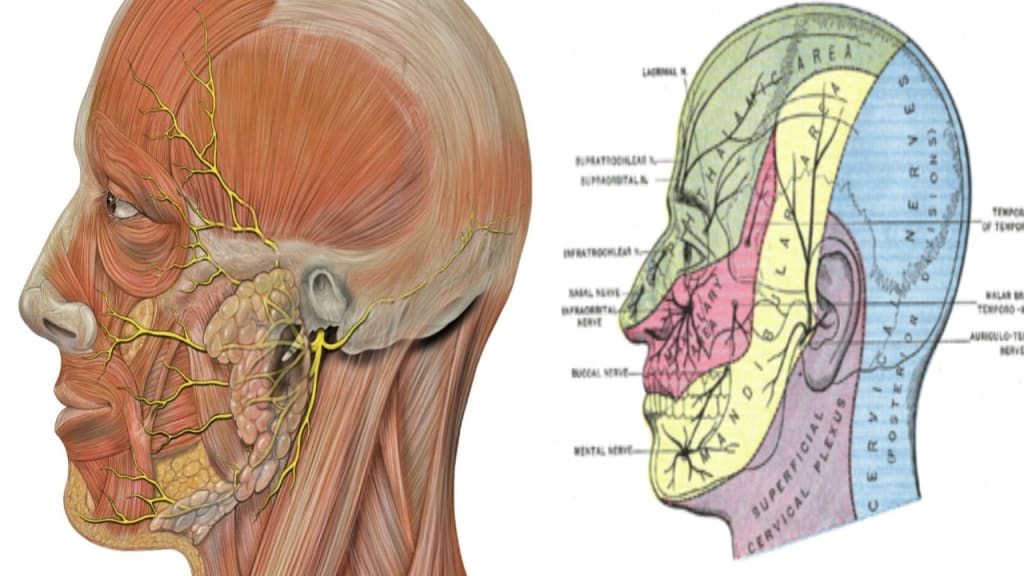The structure of the human head is a marvel of complexity and functionality
the command center for our senses, thoughts, and emotions

The structure of the human head is a marvel of complexity and functionality, serving as the command center for our senses, thoughts, and emotions. From the intricate network of bones that form its framework to the delicate tissues that house our most vital organs, the head is a testament to the incredible design of the human body.
At the core of the head's structure are the cranial bones, which encase and protect the brain. There are a total of 22 cranial bones, including the frontal bone, parietal bones, temporal bones, occipital bone, sphenoid bone, and ethmoid bone. These bones come together to form the cranium, a rigid structure that provides stability and protection for the brain.
The frontal bone forms the forehead and the roof of the eye sockets, or orbits. It also contains the frontal sinuses, air-filled cavities that help to lighten the skull. The parietal bones, two in total, form the majority of the cranial roof and sides. They meet at the top of the head along the sagittal suture, a fibrous joint that connects the two bones.
The temporal bones are located on the sides of the head, near the ears. They house the structures of the inner and middle ear, including the cochlea, semicircular canals, and auditory ossicles. The temporal bones also contain the temporomandibular joints (TMJ), which connect the jaw to the skull and allow for movement during activities such as chewing and speaking.
The occipital bone forms the back and base of the skull, containing the foramen magnum, a large opening through which the spinal cord passes. It also features the occipital condyles, which articulate with the first cervical vertebra, known as the atlas, allowing for the nodding motion of the head.
The sphenoid bone is located at the base of the skull, behind the eye sockets. It is often described as resembling a butterfly or bat, with its wings extending laterally on either side. The sphenoid bone plays a crucial role in forming the floor of the cranium and housing the pituitary gland within the sella turcica, a depression in the bone.The ethmoid bone is located between the eyes, forming part of the nasal cavity and the medial wall of the eye sockets. It contains numerous air cells called ethmoidal cells and forms the superior and middle nasal conchae, which help to humidify and filter the air as it passes through the nasal cavity.
Surrounding the cranial bones are the scalp and facial bones, which contribute to the external appearance and functionality of the head. The scalp consists of five layers: the skin, connective tissue, aponeurosis, loose areolar tissue, and periosteum. It serves to protect the underlying structures of the head and provide sensation through its rich network of nerves and blood vessels.The facial bones form the framework of the face and provide attachment points for the muscles of facial expression and mastication. There are 14 facial bones in total, including the maxilla, mandible, zygomatic bones, nasal bones, lacrimal bones, palatine bones, and inferior nasal conchae. These bones come together to create the distinctive features of the human face, including the nose, cheeks, and jaw.
The maxilla is the upper jawbone, forming the majority of the hard palate and contributing to the formation of the nasal cavity and orbits. It also contains the sockets for the upper teeth. The mandible is the lower jawbone, the only movable bone in the skull, allowing for functions such as chewing, speaking, and facial expressions.The zygomatic bones, or cheekbones, form the prominences of the cheeks and contribute to the orbits. The nasal bones form the bridge of the nose, while the lacrimal bones contribute to the formation of the orbits and house the lacrimal sacs, which help to drain tears from the eyes.
The palatine bones form the posterior portion of the hard palate and contribute to the formation of the nasal cavity. The inferior nasal conchae are thin, scroll-like bones located within the nasal cavity, helping to increase the surface area for humidifying and filtering air.In addition to bones, the structure of the human head also includes various soft tissues, such as muscles, blood vessels, nerves, and organs. These tissues work together to support the functions of the head, including sensation, movement, and communication.
The muscles of the head and neck are responsible for movements such as chewing, swallowing, and speaking, as well as facial expressions such as smiling and frowning. These muscles are innervated by the cranial nerves, which emerge directly from the brain and control sensory and motor functions throughout the head and neck.The blood vessels of the head supply oxygen and nutrients to the brain and other tissues, while the lymphatic vessels help to drain excess fluid and waste products from the head and neck. The nerves of the head transmit sensory information such as touch, taste, smell, and vision to the brain, as well as motor signals for movement and coordination.
Finally, the organs of the head, including the brain, eyes, ears, nose, and mouth, play essential roles in processing sensory information, maintaining balance and equilibrium, regulating body temperature, and facilitating communication with the external environment.In conclusion, the structure of the human head is a complex and intricate system of bones, muscles, blood vessels, nerves, and organs that work together to support the functions of the brain and senses. From the cranial bones that protect the brain to the facial bones that form our distinctive features, every aspect of the head's structure is finely tuned to enable us to interact with the world around us and navigate our daily lives.





Comments
There are no comments for this story
Be the first to respond and start the conversation.